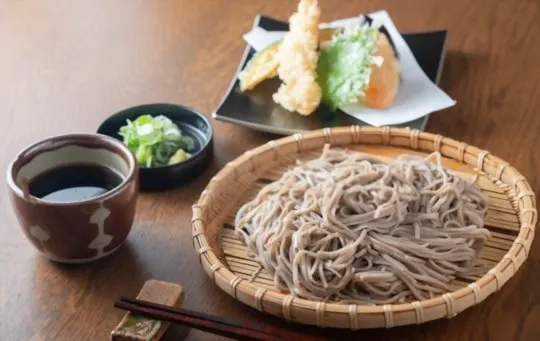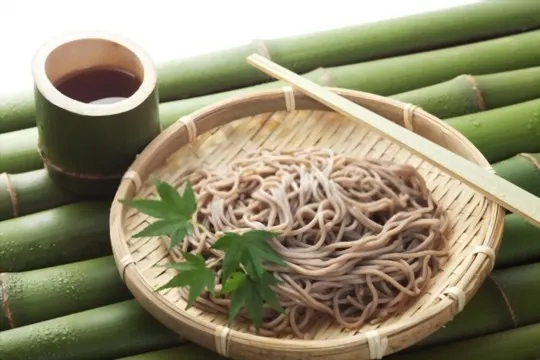One of Japan’s greatest culinary exports, soba noodles, is becoming increasingly popular in the United States.
You may have seen it in sushi restaurants or on social media, even if you’ve never tasted it.
Price and appearance-wise, soba noodles may not be your first choice.
However, soba stands out from the crowd when it comes to flavor and nutrition.
So, if you’ve finally decided to try this noodle, you’re in for a treat.
You can make many recipes with soba noodles, from simple to complex.
But before you even begin the cooking process, it’s essential to first learn what do soba noodles taste like.
Only then will you be able to relish this unique dish to its fullest potential.
What are Soba Noodles?

The Japanese sure know how to make delectable food.
From sushi to sashimi and tempura to teppanyaki, there’s no doubt that Japanese cuisine is one of the most popular in the world.
And one of the most well-known Japanese dishes is soba noodles.
Soba noodles are made from buckwheat flour and are a popular Japanese cuisine staple.
You can serve them in many dishes, and they are perfect when used in soups or salads.
If you’re looking to try soba noodles, you’ll likely find them at an Asian restaurant.
And if you want to make them at home, it’s surprisingly easy.
Just be sure to follow a good recipe that you can find on the internet.
Besides, if your supermarket has a dedicated Asian aisle, you might be able to find packaged soba noodles near the other Asian-style noodles, such as udon and ramen.
What Do Soba Noodles Taste Like?

A 100% buckwheat flour soba noodles taste nutty and are slightly similar to somen noodles.
The noodles have a rubbery texture and are darker than regular noodles.
But they have an impressive advantage of being suitable for eating both hot and cold.
The soba noodles’ unique taste, texture, and versatility make them the perfect noodles to use in salads and a refreshing summertime favorite.
Soba noodles are rich in carbs and fiber and also contain protein and fats.
Even better is that these noodles are gluten-free and hence, easy on your stomach.
But watch out for those that have wheat flour added to them; they contain gluten.
Soba noodles alone do not contribute much flavor to excite your palate, but the trick lies in the seasonings you add to them.
The more, the better works for these noodles; you can never ask for anything less.
Depending on your chosen seasonings, the flavors fuse to give aromatic and mouth-watering results.
The secret of soba noodles is that their natural properties enhance whatever ingredients you add to them and vice versa.
So, will you benefit from eating soba noodles? Yes, they have a higher mineral content than most other noodles.
So, replacing your everyday noodles with soba will boost your metabolism, promote heart health, and help fight antioxidants.
Another primary reason for you to choose soba noodles is their ability to regulate blood sugar levels.
Those with type 2 diabetes will find this noodle beneficial as it can moderate sugar levels.
How to Prepare and Cook Soba Noodles?

Preparing soba noodles is very similar to any other noodles, and the easiest way is to follow the instructions on the packet.
Generally, soba noodles need to be cooked for about 7 minutes.
Then, rinse them with cold water to get the perfect texture.
Soba noodles can make the most incredible dishes or even make you question your cooking skills.
So, we’ll uncover to you some of our favorite ways to cook these healthy noodles:
- Serve the noodles with a soup: There is nothing better than enjoying noodles with a hearty soup. The best and most enjoyed soup is a warm dashi broth, but you can also try and explore other options.
- Make a stir-fried dish: Stir-fry cooked soba noodles in a ketchup and sesame oil mixture. You can add chopped vegetables and chicken slices to enhance the taste and get more protein.
- Cold soba noodles salad: A soba noodles salad tastes best when you add Japanese condiments like miso paste. Rice wine, garlic-ginger paste, honey, sesame oil, and soy sauce are other ingredients you’ll need.
Although soba noodles are a boon to noodle lovers, they can give allergic reactions to some, especially those that are allergic to buckwheat.
However, these instances of allergies are rare and can be tackled as long as you eat in moderation.
Final Thought
Soba noodles make the perfect treat for any time of the day, no matter the season.
So, if you’ve had doubts about these odd-colored noodles at a convenience store, you now know they’re good for you and in more ways than one.
Try switching your regular noodles for soba and see how different they taste and if they are worth the hype.
However, if you’re on a low-carb diet, soba noodles might not be the best option as your everyday noodles.
But it’s all good if you keep things balanced.

Leave a comment